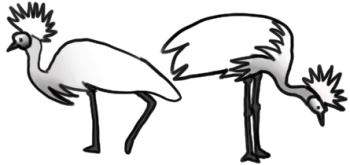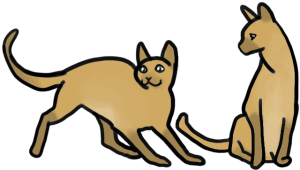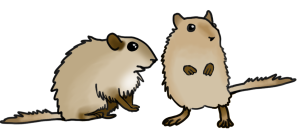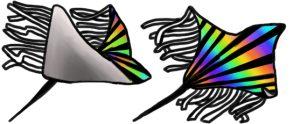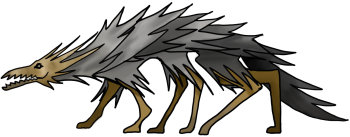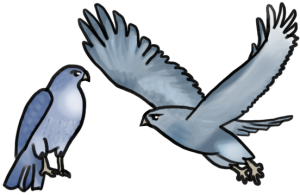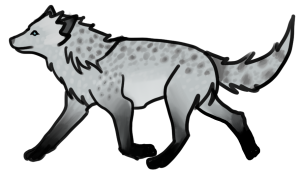Table of Contents
Iromakuanhe Fauna
As opposed to the domesticated animals in the Iromakuanhe Astral Commonwealth, these are the various wild animals that can be found planetside on planets within the Commonwealth's influence.
Maekardan
Animals found mainly on the planet Maekardan.
Sarngika
A long-legged wading bird with white feathers and buff plumes. It has a long, thin and slightly curved beak with a fringed crest of feathers on the top of it's head. Normally a very silent bird, it does croak loudly when it's territory is threatened or during mating season. Their nests are small platforms of sticks made in shrubs. There are two distinct types of Sarngika, the stockier Herd Sarngika lives in dry, grassy areas where it is found usually accompanying herdtitans, since it eats insects and small vertebrate prey disturbed by the herdtitan's grazing. The other type, the River Sarngika, is lankier and lives by small rivers and streams in the Nuocr, where it eats insects and small fish found in the muddy, marshy banks.
Type: Insectivore Social Type: Flocks
Neesh
The neesh is a desert creature that has four legs with retractable clawed paws, a thin coat of fur, a protruding tail from its rump, and pricked ears. Its coat is usually beige, golden, or ruddy brown, or a combination of those colorations. It feeds on sandrats and is feared by some Iromakuanhe, though the neesh has never reportedly eaten or hunted an Iromakuanhe. They can even make good pets if properly trained and treated well. They are not overly aggressive animals, though do play rough and it should be noted that acccidental injuries due to rough play have happened during interactions with the neesh. This animal will seek kinship with others and desires a pack to live with, though solitary animals have been spotted.
Type: Omnivore Social Type: Packs
Sandrat
Sandrats are one of the lesser members of Maekardan's warm-blooded mammal species, generally being no larger than a grown man's fist and armed with little more than sharp incisors and a prodigious jumping ability. The Sandrat has a body that is often compared to a lancehead, with an pointed, elongated head and slightly narrower torso and waist section, flaring significantly around around the shoulders and hips. Their legs are strong to a point that defies their size, and their senses are quite developed.
Hunters and trappers often say that if one can catch a nest of sandrats, the legs make good eating. This is only true if one can do so before these agile rodentia make their yard-pounces or fleet escapes.
Type: Herbivore Social Type: Nests
Hlarai
Animals found mainly on the planet Hlarai.
Matai Skyfish
Matai Skyfish are the provincial mascot of the Matai electoral district, and of the city which lies at its center, a genetically engineered species said to have been the savior of the city. It resembles a brightly-colored sail-shaped fish decorated in long black stripes which spread out from its thin rudder-shaped tail out to the thin and elongated mouth that rests directly in the center of its vertically impressive body. Light-emitting cells in the skin allow it to create patterns to draw in prey, which are then grabbed in large swathes by long self-motile ribbons covered in a sticky combination of enzymes that also paralyze insect species. Although technically not air breathers, they have special organs which can store oxygen breathed in while swimming with sufficient capacity to remain in the air for especially long periods of time. The flight mechanism is similar to that of the Frahxit Floatcrab, using sacs of gaseous helium inside of the fins and electrostatic manipulation via specialize cells in the tail.
Skyfish can grow to be up to a meter in height and thirty centimeters in length, with another fourty with the addition of the ribbons.
The psychology and intelligence of the species was also notably modified from the original, non-sentient stock. The capability for pattern recognition, a nurturing instinct and limited decision-making were the result of their genetic enhancements. Subsequently, it was required to alter their behavior by implanting genetic memories and associating certain responds with specific sound frequencies. Special 'thumper' towers and facilities emit ultrasound frequencies which invite nearby Skyfish to rest in the water and stay out of the airways, while most craft can have their communications equipment emit signals to prevent the Skyfish from approaching them, as their innate curiosity may drive them to. However, a number of original psychological attributes have been preserved. Notably, the fish are immensely docile and harmless to anything larger than small insects, and tend to form large social groups.
In the early era of settlement on Hlarai, ecological damages caused by the accidental introduction of a hardy, fast reproducing insectoid from Mazerin which had been dormant in the ice floes for centuries. The importation of the high quality ice from the great glaciers and ice shelves for festival statues had allowed a few hundred of the creatures to be thawed out. Although analysis of the remains indicated that it would have been impossible for most of the entombed to survive this series of events, an original four males and one female had managed to develop a resistance to freezing during the last days of an unknown glaciation period eons ago, and began to rapidly reproduce taking advantage of the abundant resources and temperate climate of the surrounding region and overwhelmed the native biosphere.
The Skyfish were retrieved from a local species of tropical fish that had the ability to survive long periods out of the water, gliding just above the surface through clouds of floating spores and small fauna on scaly, self-motile flaps covered in a sticky substance. Although not viable as food because of an extremely acidic taste, nor as pets as each individual demonstrated suicidal behavior when isolated in small areas, the Skyfish's ancestor was thought to have the potential to be an ideal weapon against the invasive species. After nearly fifteen years of genetic engineering and artificial selection through several generations, the Hlaraians produced a predator that was able to reduce the invasive population to a fraction of its number and lock it in ecological equilibrium.
Matari Luodfish
The Matari Luodfish (pronounced 'lewdfish') is a common pisciculture species found around the shallow coastal reefs and canal cities of Hlarai. Despite their place as bottomfeeders, they possess useful biological qualities that allow them to purge polutants from their bodies and sequester them in their crystaline leavings. As a consequence they are often kept in the canals of ships and the water filtration tanks of some seagoing and space vessels, where they assist water protection and provide a cheap (and in many municipalities- free) form of protein for those who live nearby.
Yellow and blue-striped in coloration, Luodfish have a particular shape, rather like an eel wave that their tails fork at the end and their head is adorned with a spade-like wedge that allows it to scoop up and filter through the nutrient-rich floors of waterways and shoreline. This spade is also a defense mechanism, used to entrench and cover the body of the fish to escape predators. Unfortunately for the fish, this tendency to entrench and wait for predators to grow frustrated and leave them makes them easy quarry for Iromakuanhe fishermen.
The flesh of luodfish is white and oily and coats the mouth in a rich film when eaten raw. It lends itself well to being seared as well (requiring no cooking oils), and has a tendency to fall apart when boiled or braised in soups and stews, making it more of a proteinous thickener than a main meat portion.
Type: Bottomfeeder Social Type: Schools
Bistani Graimel
Often considered the king of Hlaraian predators, the Bistani Graimel is a hexapodal carnivore which appears to be a chimera of species on other worlds, but is in fact a natural relative of the four-winged avian species on the planet. Whereas other species adapted their limbs into wings, the Graimel and its now extinct kin remained landbound, but retained their feathers, which adapted to suit the needs of a fast-moving consumate predator. The Bistani variety is the only remaining specimen of its genus, a strong six-legged canine creature with a beak with sharp hexagonal spacing that resembles teeth, covered in a thin layer of downy fuzz, actually part of its plumage. Over these are thicker and slightly metallic plates adapted from the long feathers that would have been used for flight, giving it a fearsome appearance. The Bistani Graimel reaches up to a two meters tall and five meters long, though captured specimens near settlements rarely reach a third of this size.
It excels at leaps and prolonged charges, but is poor at turning and starting off after prey. For this reason, they travel in small hunting groups of two or three and will have one charge at and frighten it into fleeing. Although it may have distance and speed, it is not long before the prey gives out, or is crashed into from the side by either of the partners in the hunting group. Graimel are monogamous and lay eggs, in clutches of seven to twenty three. Mortality among hatchlings is at roughly ninety percent for the first Hlaraian year, for the duration of which they are soft-feathered and vulnerable.
Conservation laws explicitly ban hunting or capturing this species. Ignoring the violations to safety and law, some ranchers and frontierspeople out on the fringes of the settled places claim to have tamed a 'brood' of Graimel, using special symbiotic implants that emit pheromones pleasing to the species, and allow the individual to apply traditional 'conditioning' techniques to train them. At their physical peak of roughly 26 years, Graimel may be ridden by one to three individuals at once.
Type: Carnivorous Social Type: Packs
Markley Altasir
Perhaps the only thing more beautiful than the technologically sophisticated resort town built around the hotsprings of Markley are the mysterious Altasir, four winged birds of paradise with exotic, fiery plumage and a propensity for serenading the volcanic 1000 Nightmares region in their chillingly beautiful 'wraithsong'. Altasir are the archetypal example of Hlarai's local six-limbed avian species, with wings tipped in aerodynamic crystalline blades seemingly adapted from feathers that gradually transition to a finer fuzz on the chest and upper legs. They tend to vary between 4 to 7 inches in length, and have few differences in coloration or appearance, save that the females sing only during the mating season and have earthy and ashen feathers to blend them in with the volcanic ash and rocky landscapes, while the males have brighter plumage and sing year-long.
Altasir males travel in large flocks of fourty to a hundred, and tend to travel for days on end in search of insect nests, fresh carcasses (for the insects which lay their eggs in them) or recently dried mudflats. The females nest in large rocky spires that dot the landscape, using their singing as a means to allow young, healthy males to home in on their nests to mate during the spring. They will roost for a few weeks before leaving once the young have hatched. Afterward they tend to leave the nest and reform flocks formed from the other males that gathered at that spire. Inversely, a male that has not found a mate at a spire will continue on to the next one, and will not break off from its flock until it has found a suitable mate… or collapsed from exhaustion.
Type: Insectivore/Omnivore Social Type: Flocks
Whelchist
A slippery creature of the Ether river region and Tikopia island region of which there are two varieties, fresh and saltwater. It is long as it can get to over two meters and limbless. They are both a shade of lavender when taken out of the water, but are black as the void when underwater. They have two eyes on either side of the front of their slender bodies and several jutting teeth that often show over their lower or bottom lips, making it apparent they have a strong jaw.
The saltwater welchist contains natural painkillers in the gel that covers its body and it is rumored that Solan Starworks got the idea for Prajna from this creatures jelly-like exterior coating, though the two are wholly different in properties. The welchist's gel-coated skin makes it hard to catch with one's hands, though several adventure seekers try to do so often by dipping their hands in water and then pressing them into dry sand and gripping them that way after baiting them. That or they are farmed and kept in netted enclosures.
The freshwater is much more flavorful than the saltwater welchist and they cannot be farmed, instead they must be caught in the wild.
Type: Carnivore Social Type: Solitary
Kumaran Zel-Stuurgaon
The Zel-Stuurgaon hails from the Kumara on Hlarai and is a monolithic creature that possesses a multitude of eyes all over its body. Some say the Stuurgaon can see what Iromakuanhe people cannot. It is farmed in great fisheries in Kumara as well as swims the oceans of Hlarai and has a mating season prior to which it swims great distances in order to drop its eggs off in the water off of Gollarde Coast. It grows over nine to ten meters long and has pricked fins on its back, belly, and tail. Its eyes are not concentrated in one place but are all along the body. It has a green coloration to it, save for the eyes which are different shades of yellow, orange, and red.
Type: Omnivore Social Type: Flocks
Kumaran Minecarp
From Kumara on Hlarai, this is a type of salt-water creature that lives in the oceans and often can be found diving into deep shafts in the water down to where they lay their eggs and foster them, protecting them from the mouths of other sea-dwellers. The creatures are careful not to stray too far from their dwellings at the base of the ocean, but are often caught outside of their food in search of other food, algae, or micro-life. The taste of the minecarp is oily and savory and it is often farmed, though the people of this area attest that none of their fish are genetically modified. Instead, they are treated well, given ample room and hides to use while they mature, and are not over-farmed. They are small creatures relative to the other creatures of the sea and have yellow or orange bodies that range from ten inches to one meter. Sometimes they are kept as pets as these animals only grow as large as their environment permits.
Type: Carnivore Social Type: Family
Mazerin
Animal species found mainly on the planet Mazerin
Mazerin Frost Goose
The Mazerin Frost Goose is a medium-sized waterfowl, with hawkish features and a sharp beak that allows it to peck holes in frosted-over ponds and lakes, allowing it to get to the plant and animal life underneath. Generally a dark gray or light blue, these birds remain near the equator where the climate is more agreeable. They are hunted quite regularly, and are fairly common as food.
Snow Neesh
Technically not the same species as the Neesh found on Maekardan, the Snow Neesh of Mazerin is a large wolf-like creature with thick white fur dotted with small black ring-like spots. A fierce hunter that preys on pretty much any meat it can find out in the harsh Mazerinii climate. During the extremely cold winter season, the Snow Neesh goes into a state of hibernation that allows it to survive the coldest months of the already freezing planetary surface. Unlike the Neesh of Maekardan, there has never been any accounts of domestication of the Snow Neesh.
Type: Carnivore Social Type: Packs
Yahti
As tall as an Iromakuanhe and a half, the Yahti is a towering mammalian beast with long fur covering it's body and a bony ridge atop it's head that extends into three pronged horns. Though it usually uses all four of it's clawed paws for walking, it can stand on it's hind legs to attack or intimidate opponents. The Yahti appear to be highly intelligent for animals, capable of digging out small caves with its front claws and building nests for sleeping areas. It appears that the females (which tend to have smaller horns and less-prominent ridges) are the primary hunters for family units while the male stays at the homestead, guarding the food stores, young, and family territory.
Type: Omnivore Social Type: Family
